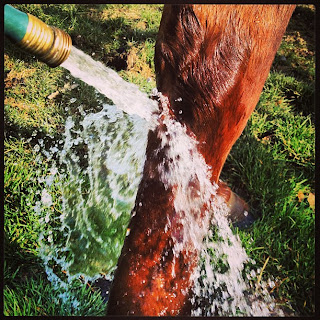The Vet Vist, or how Purdue is the only place I ever want to take my horse ... ever
This post is über photo heavy and sort of a novel. I apologize for nothing ...
Two weeks ago Thursday, I pulled Guinness out of the field only to find a hot leg and a little swelling under his right knee. Not a lot of lameness was apparent, but I still wasn't taking any chances. With all the heavy mud we've been dealing with recently, a lot of the horses at the barn have had unexplained swellings and lameness. I immediately worried about a possible tendon strain or big injury.
Two weeks ago Thursday, I pulled Guinness out of the field only to find a hot leg and a little swelling under his right knee. Not a lot of lameness was apparent, but I still wasn't taking any chances. With all the heavy mud we've been dealing with recently, a lot of the horses at the barn have had unexplained swellings and lameness. I immediately worried about a possible tendon strain or big injury.
 |
| Can you see it? Yeah, me neither. |
Of course, being in the middle of nowhereland country means that the closest vet capable of diagnosing possible tendon injuries and operating a leg ultrasound is Purdue University's College of Veterinary Services. That's a two hour trailer ride from my barn. I made the call and set up an appointment, immediately beginning to second guess myself, worrying outrageously, and generally being a giant ball of stress. Meanwhile, I still had Guinness on strict stall rest (only turnout in the indoor while his stall was being cleaned), and I kept the area wrapped, and poulticed. I cold-hosed the area daily to bring the heat out, and did handwalk some on the roads to help with sanity and any stocking up.
Finally the day of the appointment dawned. Except for a brief moment of not wanting to be caught in the indoor arena (think running, bucking and generally leaping like a fool), and being a little difficult to get on the trailer, we got on the road without a lot of issues. Two hours later found me at Purdue, trying not to hit college students with the truck/trailer and desperately looking for any sign that said "trailer parking".
I was so proud.
 |
| Can you call it a lameness exam when there's no lameness? |
Our exam was pretty straightforward. The vets asked about the history of lameness, and I explained about the foot issues and the ankle arthritis history. They palpated the area, remarked on the swelling (which was huge and hot, due to the trailering and the running around like an idiot), and had us trot up for lameness. The vet corroborated my findings. No lameness in the front right. Actually, he found GP to be off on the front left, instead. This isn't surprising. Stall rest always aggravates the fetlock issues in that leg.
A short conference later, and we decided an ultrasound was a good option to rule out any tendon/ligament damage to the area. Radiographs to check on the bone structure were also offered, but neither the vet nor I felt that was a valid option to explore. So we headed off to get an ultrasound. Step one? Shave the legs. Both legs were shaved as the vet wanted to compare the normal leg with the leg with the swelling to get a read on "normal". Then we proceeded with the ultrasound ...
 |
| Naked legs! |
 |
| Ultrasound time! |
The whole process took quite a long time. The vet was very thorough with the ultrasound, pointing out things that may become issues in the future (bone spurs? Ugh ...) and also how the tissues were all very dense and looked just normal as can be.
Normal? How awesome is that?
In fact, the diagnosis is a mild sprain to the area or a possible muscle contusion. Most likely due to an awkward step in the mud or a kick to the site. Either are possible. Both are not a big deal. Both a treatable and not season enders. This is all fabulous news, and I feel so much better about the injury after getting a confirmation it wasn't a horrible thing.
In fact, the diagnosis is a mild sprain to the area or a possible muscle contusion. Most likely due to an awkward step in the mud or a kick to the site. Either are possible. Both are not a big deal. Both a treatable and not season enders. This is all fabulous news, and I feel so much better about the injury after getting a confirmation it wasn't a horrible thing.
We went home with a slip of paper detailing everything that the vets found, and telling me to keep up with the stall rest, cold-hosing, poultice and wrapping. So, we have ...
 |
| Define: Coldhosing, verb. A long boring process of spraying ice cold water onto an injury to reduce swelling and heat. See also "catching up on reading novels" |
 |
| Handwalks are only fun when the sun is shining, and it's not frigid. Hooray spring! |
Comments
Post a Comment